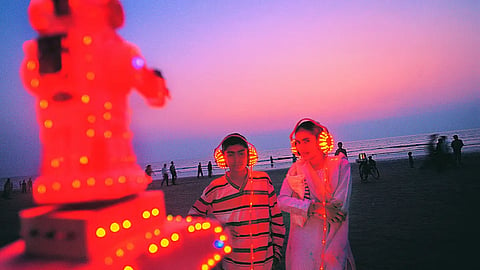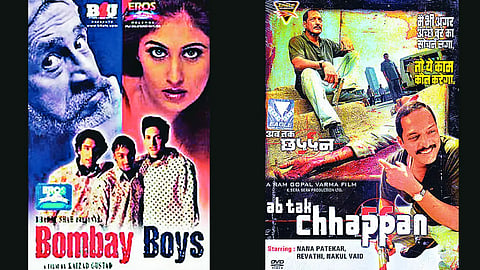Jamli Mohalla, located aro-und Bapu Khote Street in south-central Mumbai, is densely packed with traders of all kinds—glass works, iron and steel merchants, acr-ylic stores, furnit-ure makers and more. In the middle of this typical, old-world street is the small shop of Moha--mmed Ismail, a custom furniture mak-er. He was previously a dhaarwala, a knife sharpener, having inherited the business set up by his grandfather who moved to the city from Iraq in the 1930s. Ismail Bhai was also a former member of the appropriately named ustra (folding razor) gang, headed by his nephew Hussein, who he says was a sharpshooter often contracted by the police for hit jobs on other gangst-ers. Hussein paid the ultimate price for his association. Bet-rayed by his own aunt, he was shot dead in 1987. But not before making his mark. As Ismail Bhai says: “Hussein ne bahut wicket gira diyela hai” (“Hussein took many wickets”).
Bol Bachchan: Speaking Together And Sticking Together In Mumbai
Evolving out of the streets and the migrant multitudes, Bambaiya, the language of the taporis, took final shape and gained legitimacy from Bollywood
The entire phrase—with its cricketing metaphor, Marathi influence, and the cadences with which it is said—deftly demonstrates the collective heart and soul of Mumbai/Bombay, inhabited as it is by diverse ethnic, linguistic, religious, social and economic groups, all jostling for literal and figurative space while trying to grasp the grand, oft-en illus-ory, mythic allure of the city. Ismail Bhai speaks Bambaiya. In particular, his speech is heavily lac-ed with bhai-giri, the street style of taporis—wannabe thugs, wastrels, roadside Romeos, smart ale-cks, and of course, the quintessential fast-talking and endearing Bombay hust-ler of Hindi cinema. While Bhai is bro, the suffix giri is a mode of operation, code, style or trend. The successful Bolly-w-ood franchise of Munnabhai popularised Gandhigiri, a snappy expression to descr-ibe rightful civil disobedience, in its filmic scenarios of the good fight. The crowd-pleasing film dialog-ues found great favour, propagating the qui-rky, entrepreneurial, inclusive and fun side of the city that belonged to all. From stockbrokers to gangs-ters, ricks-haw drivers to civic workers, gym inst-r-u-ctors to film stars, one common idiosyncratic and beguiling tongue is heard on the streets of akkha Mum-bai. Is this then the true ess-ence of the city, wafting abo-ut effortlessly bringing toge-t-her all its inhabitants? Is this the glue that binds the disparate metropolis?
The writer, journalist and raconteur Rafique Bag-hdadi, who grew up in the central district of Mazgaon, says Bambaiya was made popular by Hindi cinema. It existed all around him, with the influen-ces of predominantly Konkani Muslims and Goan and East-Indian Catholics of the area. Hindi cinema has always mined the street for cha-r-acters and their colourful ways. Baghdadi has been conducting a Sa’adat Hasan Manto walking tour for many years, traversing places the iconic writer lived, worked at and frequented. Manto oft-en wrote empathetically of street life in Bom-bay, but his characters rarely speak the lan-gu-age of the street. In one story, Dhondu, the pimp at the street corner outside Manto’s favourite restaurant Sarvi, opposite Nagpada police stat-ion, complains about the melanc-holic, moody pro-stitute Siraj, saying, “Saali ka mastak phi-r-ela hai” (“The bitch’s head is screwed up”), indicating his Bombay street cred. Manto rarely used Bom-bay slang, choosing instead a standardised literary Hindustani/Urdu, which in many ways is the dominant spoken language of Hindi cinema. However, in the Hindi novelist and TV scriptwr-i-ter Manohar Shyam Joshi’s vertiginous, enigmatic post--modern novel Kuru-Kuru Sva-ha, a set of corresponding characters to Manto’s story, Manohar the narrator and Babu the pimp, have an entire Bam-baiya exchange on Cho-w-patty beach. Babu’s succi-nct proposition “Tafri hone ka?” (Want some fun?) elicits a phoney enquiry from Mano-har, and in reply Babu menti-ons a “nava gharelu chhokri”, a new, homely girl, who he says: “Abbi kiska saath baitha nai. Usku rup-ya ka jarurat. Din ka time hi aayinga. Pachas rupya lenga. Bolo hone ka? (She has not ‘sat’ with anyone yet. She is in need of cash. Will come only during the day. Takes Rs 50. Tell me, you want?) This typical Bambaiya with its unique infl-ections and word choices, is ric-hly suffused with the cool breeze of the Arabian Sea, the ubiquitous odour of drying fish, the comf-ort-ing clatter of local trains, the promiscuous den-sity of slum dwellings and chawls, and the sal-ty perspiration of the industrious, enterprising city.

The multi-talented actor, dancer and comedian Jaaved Jaaferi has often played Bombay street characters. Talking to this writer recently, he says he picked up cues from his father Jagdeep’s screen roles, which were drawn from the legendary Hin-di film comic’s experiences of living on Bombay streets in the 1940s. Jaaferi grew up in the Catholic suburb of Bandra, but picked up influences from local tra-ins, attending Muharram in Bhendi Baz-aar every year, and the film community at large. This would all innovatively reflect in his collaboration with the writer Arshad Syed, director Sha-hid Sayed and resear-cher Imtiaz Baghdadi in Jaffe-ri’s iconic sketches for the mid-1990s Channel [V] TV show Timex Timepass. Notably, during the late-1990s, his rap song Mumbhai for the film Bombay Boys, dexterously showcased Bambaiya, in all its filmy glory. Jafferi however, points to Guru Dutt’s classic noir film Aar Paar, which featured a young Jagdeep, as an outstanding example whe-r-ein several characters speak typical street slang.
Bambaiya has mostly been used for comic effect on screen, but as Arshad Syed says, the gangster films of the 1980s and 1990s—including Naam, Gang, Satya, Vaas-tav, Company, Ab Tak Chha-p-pan, among others—had characters speaking Bambaiya with varying degr-ees of authenticity. The cheeky and charming song Aati Kya Khan-d-ala from the film Ghulam, transformed into a pop-ular catchphrase, illustrating as it were, the symbiotic, recurs-ive rel-a-tionship between the scr-een and the street. And actors such as Jac-kie Shroff, Arshad War-si and Gov-i-nda truly embody the Bamb-aiya spirit, even if their screen characters are often more standardised. The 1988 outlier Sal-aam Bombay, is also notable for its authentic street depictions and dialo-gue. It is rare tho-ugh, that the main lead in a Hindi film speaks entirely in Bambaiya. Three exceptions shine through: Amitabh Bachchan in Amar Akbar Anthony, Pawan Malhotra in Salim Langde Pe Mat Ro and Sanjay Dutt in the Munnabhai franchise. As Jaaferi, Syed and Baghdadi say, wri-ters, actors and directors draw from their immediate surroundings to give authentic colour to Bom-bay characters. The most adept at this, all point out, were director Man-m-o-han Desai, screenw-riter Abrar Alvi, and writer/actor, Kader Khan, who Bagh-d-adi says, never really got his due.

Salim Langde Pe Mat Ro, directed by Syed Mir-za, is set in Dongri, the heartland of Bambaiya. As a review by Nandini Ramnath points out, in Mir-za’s words, the lead character of this iconic film exploring the “social reality of a young, Muslim and uneduc-ated hoodlum along with history”, declares in typical street style: “Apna bhi time aaye-nga re.” (“Our time will also come man”). The Bombay underdog knows that it’s all within his grasp. This aspirational expression has found its way into the recent hit film Gully Boy, wherein Bambaiya is infused with the contemporary flavo-urs of rap and hip-hop. Salim Langde Pe Mat Ro, however, remains outstanding in how Bambaiya remains very close to the street. Ref-l-e-cting the wor-ld of gangsters, grifters, and hustlers, Salim is nicknamed langda or lame. There are many other Salims, his character informs us at the very outset—Salim Chechak, Salim Kania, Salim Tempo, Salim Honda. Identi-f-ied by their physical attributes (pockmarked, cross-eyed) or by the vehicle they use (Tempo, Honda), these nickn-ames are a common feature in the Bambaiya realm. Gang members or even local thugs, are often chaptya (flat-faced), taklya (bald) or machmach (blabbermouth), as the late associate of Chhota Shakeel (chhota indicating small or younger), Fahim Ahm-ed Sharif from Bhendi Bazaar, was known. This heartland of Bambaiya, of Mirza’s film, of Ismail Bhai’s neighbourhood—Kamathipura, Nagpada, Dongri, Muhammad Ali Road, Pydh-onie, Zaveri Bazaar, etc.-—is the realm of mawaalis—a polysemous Arabic word (the plural of mawla from the root waly) originally used for non-Arab Muslims in the subcontinent, which, over time, fell into semantic pejoration (the gradual depreciation of a word’s value) to refer to undesirables, goons and criminals.
The work of Abdus Sattar Dalvi, the founding head of Mumbai University’s Urdu department, has explored the linguistic history of Urdu in Bom-bay and Konkani Muslims. The first ext-ant example of Bambaiya he says, is the autobiography of a migrant from Kathiawad nam-ed Haji Bhai Miyan, the patriarch of the renowned Tyabji family. He chose to record his memoir not in his mother tongue Gujarati, but in a hotchpotch of the spoken forms of his adopted home. Featuring the ubiquitous kanda-batata, a phrase combining a Marathi word with a Portuguese one for the household stap-les of onions and potatoes; as well as Gujarati/Marathi lafda and vanda (quarrel/problem and issue), this early exemplar served to perh-aps codify an evolving city dialect. Earlier still, the narrative historical Marathi text Mahimchi Bak-har or Mahikavatichi Bakhar dated to the mid--15th century, integrated some proto-Urdu words for descriptions of military campaigns. The word bakhar itself is a metathesis of the Arabic kha-bar (news or information). Over the centuries, diverse influences appeared in travel accounts, poetry, and other writings, broadening the word pool and the realm of Bambaiya.
With the various spoken forms of the native Kol-is, Pathare Prabhus, Kunbis and Bhandaris of the region; Gujarati traders, proselytising Sufi saints, Parsi merchants, Konkani fisherfolk, Marathi educated elite as well as provincial millworkers; the migrant labourers from UP, Bihar, Telangana, Andhra and Tamil Nadu; the entrepreneurial hoteliers from Mangalore and small vendors from Malabar; and the linguistic registers of various tradesfolk such as kite makers, weavers, washer folk, etc; as well as, the profound colonial influen-ces of Portuguese and English, and the administr-a-tive influences of Persian; the complex tape-stry that forms Bambaiya is an the inclusive umbrella that brings all under its ragtag oneness, as reside-nts codeswitch nimbly, participating in each other’s linguistic quirks by sharing inter-o-p-e-rable wor-ds, phrases, sounds and accents. This linguistic unity remains mostly intact despite the political actions of privileging Marathi as the true lan-guage of the region. Beyond all this is perhaps what most people say Bambaiya is: the tangy, tart, spicy, sweet, crispy, soggy, crunchy anarchic flavo-urful farrago that is bhel-puri chaat.
(This appeared in the print edition as "Bol Bachchan")
(Views expressed are personal)
Gautam Pemmaraju is a bombay-based writer, filmmaker & researcher